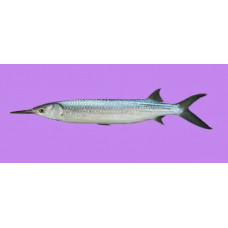Latin name
Hemiramphus far
Other name
Black-barred garfish, barred halfbeak, barred garfish or spotted halfbeak.
Identification
Black-barred halfbeaks have a laterally compressed body with an elongated oval cross-section. They have a very long, beak-like lower jaw and a short, triangular, unscaled upper jaw. The preorbital protuberance is absent. The total number of gill blades on the first gill arch is 25-36 and on the second gill arch 21-27.
Features of fish fins
This species has short pectoral fins that do not extend beyond the nasal fossa when flexed forward. The caudal fin is asymmetrical with the lower lobe longer than the upper lobe. The dorsal and anal fins are closer to the tail.
Fish colouring
The black-barred halfbeak has 3-9, usually 4-6 dark vertical stripes on the sides and the dorsum is bluish with silvery sides. The dorsal and anal fins are dark.
Distribution
Occurs in the Indian Ocean from the Red Sea and East Africa to the Pacific Ocean as far north as Samoa, north to the Ryukyu Islands and south to northern Australia and New Caledonia. The species was first discovered in the Mediterranean off Palestine in 1927, following a probable migration through the Suez Canal, and is now very common throughout the eastern basin, with recent finds off Algeria in the western basin.
Habitat
A bathypelagic species inhabiting the coastal waters of mountainous islands and continental coasts. It is most commonly found in marine areas with rich vegetation and on sandbanks.
Size
The maximum length of this species is 33 cm.
Behavior
It is a gregarious species that forms flocks.
Food and feeding habits
Adults are mostly phytocoris, feeding mainly on seagrass and to a lesser extent on green algae and diatoms.
Reproduction
They breed in spring and summer in estuaries and more temperate areas. Eggs are attached to vegetation by sticky threads and the larvae become planktonic when they hatch.
Fishing
This species is not commercially important.
Relationship with a person
Harmless.
| Classification | |
| Phylum | Chordata |
| Class | Actinopterygii |
| Squad | Beloniformes |
| Family | Hemiramphidae |
| Genus | Hemiramphus |
| Species | H. far |
| Features | |
| Conservation status | Not evaluated |
| Habitat | Pelagic |
| Life span, years | No information |
| Maximum body weight, kg | No information |
| Maximum length, cm | 33 |
| Sailing speed, m/s | No information |
| Threat to people | Edible |
| Way of eating | Algivore |
Black-barred halfbeak
Tags: black-barred halfbeak

